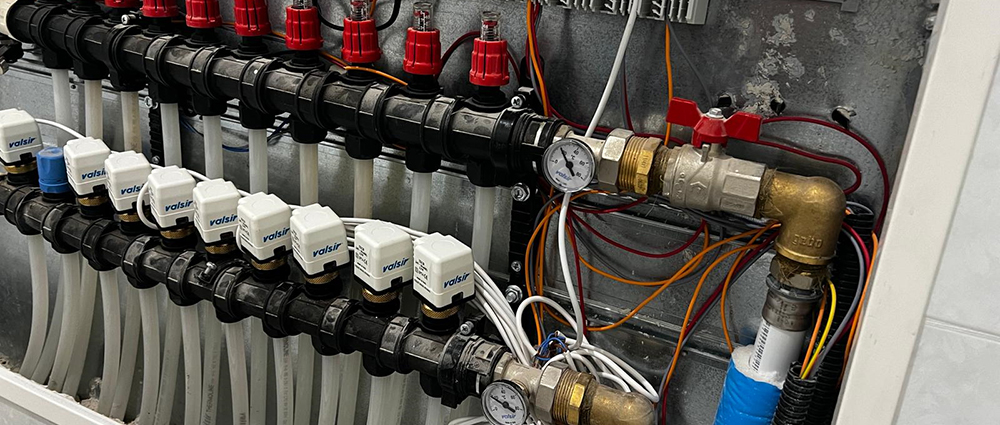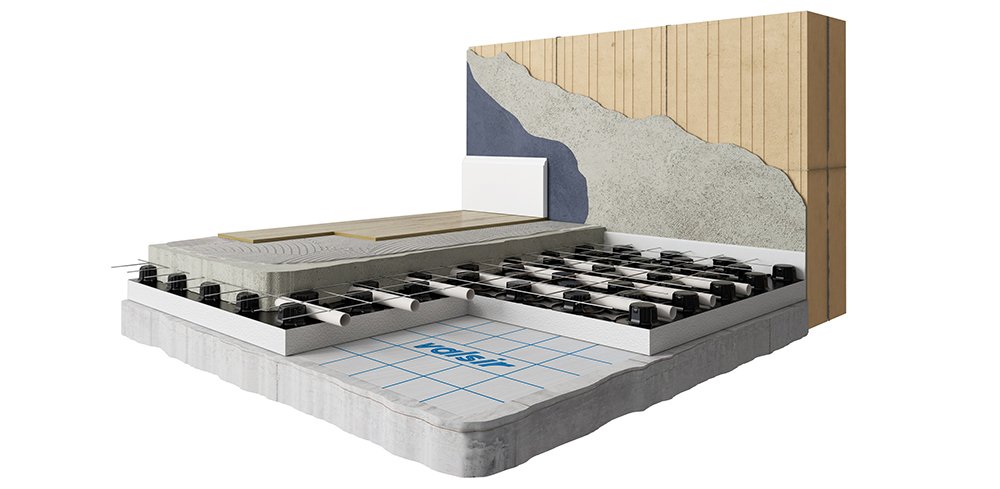Underfloor heating is a technology that allows rooms to be heated by radiating heat from the floor upwards. Underfloor heating systems are now one of the most efficient and widespread solutions in residential and commercial buildings, thanks to their ability to guarantee comfort, energy savings and architectural integration. Its origins date back to ancient times, but it is with the evolution of materials and system design criteria that it has reached its current levels of performance.
Principles of heat transmission
Heat transmission in an underfloor heating system occurs mainly by radiation, unlike radiators, which use convection (this is why we also refer to “underfloor radiant systems”).
Thermal radiation allows direct transfer of thermal energy between the floor surface and objects or people in the room. The role of surface temperature is fundamental: the UNI EN 1264 standard sets a maximum limit of 29°C in order to ensure comfort and avoid physiological discomfort.
The ideal vertical temperature distribution profile has higher values at floor level and lower values towards the ceiling, improving efficiency compared to conventional systems.

How a radiant floor heating system works
A radiant floor heating system consists of a network of pipes embedded in a screed. Low-temperature water (generally between 30 and 40°C) circulates in these pipes, fed by a heat generator.
The heat is transferred to the screed, which distributes it evenly to the floor.
Climate control is provided by thermostats and flow regulators that modulate the temperature in individual rooms, maintaining constant comfort.
Technical components of the underfloor heating system
The main components of an underfloor heating system include pipes, insulation panels, screed and manifolds. The pipes can be made of cross-linked plastic (such as Thermoline PE-X or PE-RT) or multilayer (such as Mixal), which guarantee excellent thermal conductivity, pressure resistance and oxygen barrier properties.
The screed has the function of accumulating and transmitting heat; depending on its thickness and density, it affects the thermal inertia of the system. The insulating panel, placed under the pipes, prevents heat loss downwards and contributes to overall efficiency.
The manifold regulates and distributes the fluid in the circuits and is often integrated with flow meters and thermoelectric actuators.

Energy efficiency and thermal output
Underfloor heating is highly efficient thanks to its low operating temperature. With the same level of perceived comfort, it is possible to maintain room temperatures 1-2°C lower than with a radiator system. This results in a significant reduction in energy consumption.
The radiant underfloor heating system is the most complete solution available for residential use: comfort, economy, well-being and versatility. The advantages over traditional alternatives are so overwhelming that it is now the standard for all new buildings and renovations.
The seasonal efficiency of the system is optimised when combined with high-efficiency generators, such as heat pumps or condensing boilers. In particular, the coefficient of performance (COP) of heat pumps improves significantly when operating at low flow temperatures.
Correct system sizing is essential to ensure efficiency and comfort. The calculation starts with an assessment of the thermal load of the environment, which is influenced by factors such as exposure, insulation and air exchange. The pipe spacing (distance between one pipe and another) and the thickness of the screed determine the heat output per square metre. The specific power required is defined during the design phase based on local climatic conditions and current regulations.
Reference technical standards
The underfloor heating system must be designed and installed in accordance with UNI EN 1264, which regulates sizing, temperature limits and installation conditions. Other national and European regulations establish minimum energy efficiency requirements for buildings (such as the EPBD directive).
It is important to comply with surface temperature limits, not only for comfort, but also to protect the floor coverings and the building structure.

Types of underfloor radiant systems
There are different types of underfloor radiant systems. High thermal inertia systems use thick screeds and have slower response times but guarantee thermal stability. Low inertia systems, on the other hand, are designed with reduced layers and respond quickly to temperature changes, making them ideal for modern buildings or those with intermittent occupancy. Dry systems, which do not require screed, are ideal for renovations thanks to their light weight and ease of installation.
The floor covering has a direct impact on thermal performance. The most suitable materials are those with high thermal conductivity, such as ceramic, porcelain stoneware and natural stone. Parquet is also compatible, provided that stable wood is used and the manufacturer's recommendations are followed. Vinyl and laminate flooring can be used, but it is necessary to check that they are certified for use with radiant systems.
Analysis of technical characteristics
One of the main technical advantages of underfloor heating is the distributed thermal comfort it provides.
The absence of intense convective motions improves air quality, reduces dust circulation and prevents mould formation. In energy-efficient or NZEB (Nearly Zero Energy Buildings), underfloor heating systems integrate perfectly with decarbonisation-oriented plant solutions.
It is important to assess the thermal response time in order to evaluate a high or low inertia system and define the available height for installation at the design stage.
Control and automation systems
Modern underfloor heating systems are equipped with advanced control systems. Digital chronothermostats, motorised valves and humidity sensors allow precise regulation for each area of the building.
In addition, the system can be integrated with home automation systems for remote management and automatic adjustment based on climatic conditions or the presence of occupants.
Comparison with other heating systems
Compared to radiators and fan coils, underfloor heating offers more uniform distribution and greater efficiency, with benefits in terms of comfort and energy savings, as thermal comfort is perceived even at lower temperatures. Compared to ceiling or wall radiant systems, it has the advantage of less air stratification, lower operating temperatures and better heat distribution, making it more efficient in residential environments.
Underfloor heating is therefore a complete, efficient and modern solution for winter climate control. Its integration with low-temperature technologies and intelligent management systems makes it ideal for new buildings and energy renovations.
 Italiano
Italiano
 English
English
 Deutsch
Deutsch
 Français
Français
 Español
Español
 Greek
Greek